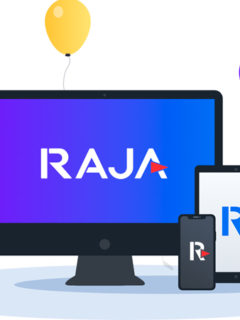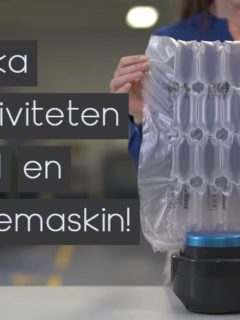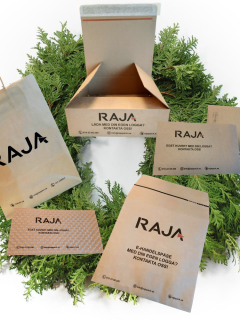Have you heard that a new European regulatory framework has been proposed for packaging and packaging waste? The Packaging Regulation with new rules and recommendations came at the end of 2022 and contains recommendations on how companies should package products. The new regulations will for the first time include rules on e-commerce packaging. If the proposal is voted through, it will of course apply in Sweden, so it may be good to familiarise yourself with the area now.
-
What will be included in the new European Packaging Regulation?
The EU’s new packaging law, called the Packaging and Packaging Waste Regulation (PPWR), aims to ensure that packaging is more recoverable and reusable by 2030. The regulation focuses on being more circular; packaging today should also be seen as packaging tomorrow. It also includes measures to reduce packaging waste and make packaging materials less complex, such as keeping plastic and paper better separated. Initially, this will only be a recommendation, which will probably later be turned into a law. Such a regulation is an equal and binding requirement for all EU Member States, in order to have harmonised rules for the entire European market. When the PPWR enters into force, it will affect all e-commerce vendors in Europe. Fortunately, many e-retailers in Sweden are already complying with many of the forthcoming requirements.
RAJA has a large selection of products that will ensure that your business or e-commerce follows the recommendations – see our selection of environmentally friendly packaging here.

-
How did the European packaging regulations come about?
The European packaging rules are the result of many years of thoughtful work to make the European market more sustainable.
Here are the main milestones along the way:
- 2015: The Paris Agreement establishes international agreements to ensure the survival of our planet. The goal is to collectively emit less CO2. This agreement has had a huge impact on our daily lives, just think of the increase in electric car driving or the ban on single-use plastics.
- 2019: Following the Paris Agreement, the EU launched the Green Deal, a list of initiatives to give member states a more modern and cleaner economy. The Green Deal signalled an entirely new direction where climate, innovation and business policies are seen as a whole. The aim is to make Europe a modern, resource-efficient and competitive economy with zero net emissions by 2050. The Green Deal was implemented by both local and regional authorities.
- 2022: The world of packaging and its waste is also addressed. Under the Green Deal, the EU launched a proposal for new legislation in November 2022: the Packaging and Packaging Waste Regulation. It is clear that packaging is important and necessary in our economy, but how we manage it must be adapted to the needs of the future.
If you want to read the entire new EU PPWR, you can find it here.
We at RAJA have throughout this period worked to develop our product range so that we can continue to be a reliable partner for all types of businesses in the future.

-
RAJA: ready for the European Packaging Regulation.
Packaging that does not fulfil the requirements of the European Packaging Act will not be allowed to be marketed in the future. So for e-retailers, this will be an important consideration.
Here is some advice on how to prepare yourself and your business for the new rules:
-
Choose packaging with circular design
PPWR requirements: The European packaging regulations focus a lot on the shape and composition of packaging. Circularity plays a major role in this. The point is that you should be able to easily rework today’s packaging into tomorrow’s packaging. Packaging that is easy to sort and recycle is preferred. This is also known as single-material packaging. For example, a package consisting only of paper and cardboard can be sorted and processed into a new paper product.
RAJA’s solutions: RAJA currently offers a range of products that are entirely made of paper or cardboard. For almost all traditional plastic products, we can offer a paper alternative, e.g. cardboard;
- Hand stretch film in paper
- Kraft paper bubble wrap
- Paper packing tape
- Paper padded envelopes
- Kraft paper packing tape

-
Choose recycled materials
PPWR requirements: As of 1 January 2030, all packaging must meet new recycling requirements. Exactly what these requirements will be depends on the type of packaging. For example, for plastics, it will mean that every packaging product must contain a minimum amount of recycled material, specifically plastics that come from recycled household waste.
RAJA’s solutions: RAJA is already increasingly introducing recycled materials in our plastic products, from bags and bubble wrap to air cushions. Our goal is to increase the demand for recycled plastic, which also increases the incentive to sort plastic.
Below are some examples of popular plastic packaging with a high proportion of recycled material:
- E-commerce bags made from 100% recycled plastic.
- Bubble wrap with 50% recycled plastic.
- Plastic bags made from 100% recycled plastic.

Equally important in this context are our products made from recycled paper and cardboard. Most boxes in RAJA’s range are made of 70% recycled paper. When we choose new products to include in our assortment, the recycling rate is always an important factor for us. In this way, we are at the forefront when it comes to future regulations.
Paper and cardboard packaging is easy to sort and recycle after use. But did you know that cardboard can be recycled up to 10 times? When cardboard is worn out, it can be easily processed into, for example, toilet paper or newsprint.
-
Avoid unnecessary weight and volume
PPWR requirements: European packaging regulations require that the weight and volume of a package be kept to a minimum – without compromising safety and functionality. In other words, packages must not be marketed with unnecessary gaps, such as double walls or double bottoms, to simulate a larger product volume. After the introduction of the bill, a maximum of 40% empty space will be allowed in e-commerce packaging.
RAJA’s solutions: We offer as many as 600 different box sizes, so no matter the product type, you can find a box that fits perfectly. The result is less empty space in the box and less need for wrapping and protection. We also encourage you to use e-commerce bags instead of cartons for the products for which they are suitable. E-commerce bags and padded envelopes can also provide good protection and are more compact, saving you both packaging materials and transport costs (the more compact you pack, the less transport volume you take up).
Choose the packaging that fits your product perfectly via our:
Or select a variable height box.
-
Targets for reuse and refill of e-commerce packaging
PPWR requirement: In addition to recycling, reuse and refill play an important role in making packaging future-proof. The legislative proposal will provide clear guidance on the design of reusable packaging and the frequency of reuse. The European Packaging Act requires 10% of non-food e-commerce packaging to be reusable by 2030, and by 2040 the target is to increase this to 50% of all packaging. This means that we as an industry need to find a new way of dealing with packaging.
RAJA’s solutions: To ensure reuse of packaging, we need to be able to adapt return logistics on a large enough scale. A lot of work is going on in the packaging and logistics industry to be able to fulfil this in the future.
RAJA is actively working on new solutions to bring to the market packaging that is strong, flexible and compact enough to be returned. Ideally, this type of packaging should also be renewable and recyclable, and we have a special focus on innovations that use cardboard. In this way, we can ensure that much less clean raw material is needed throughout the production and utilisation chain and that the amount of residual waste is significantly reduced. In this way, we can move towards a circular economy and, together with our customers, reduce the pressure on overall raw material consumption.
Benefits of cardboard as a reusable packaging material
Practical tests show that corrugated cardboard has more potential than plastic to become a reusable packaging solution. The reasons for this are as follows:
- Cardboard is a strong material, yet easy to bend.
- The production cost of designing a new cardboard package is relatively low. In addition, there is only a short lead time from prototype to finished product.
- Cardboard is often a recyclable material in itself and can easily be recycled afterwards. Cardboard can also naturally degrade quickly.
- Both production and knowledge can still be centralised locally.
- Cardboard is environmentally friendly, renewable and has the best recycling process in almost all EU Member States.
Want to know more about how your company can make good environmental choices when it comes to packaging?
Contact RAJA’s customer centre on 010 – 33 08 200 or info@rajapack.se.














